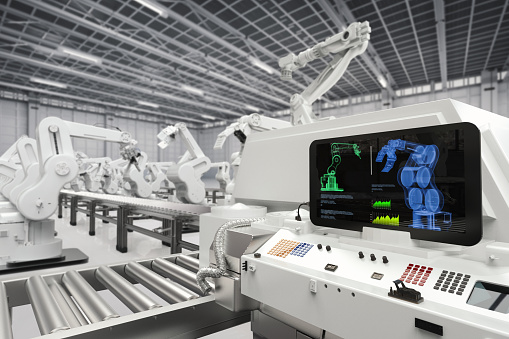The Industrial Internet of Things (IIoT) lets manufacturers optimize their factory with sensors, internet connectivity, and data analysis. This streamlines manufacturing increases collaboration and creates new experiences for the customer.

By now, most of us have some understanding of the “Internet of Things” or IoT, in which everyday items are connected to the internet and communicating with other connected devices. One example that is commonly cited – perhaps because it is memorable frivolous – is a refrigerator that tells you what groceries you need, using cameras, sensors, some data processing, and an internet connection. In a more useful realm, home automation, like a smart thermostat that learns your preferences and schedule, provides another example. In that application, the IoT is used to save energy and make your home more comfortable. Another example that has found traction in the market is wearable electronics that record, analyze, and report vital statistics, activity, and other health-related data. The opportunities and applications for IoT are nearly unlimited.
The Industrial Internet of Things
Many businesses have observed these trends and are now driving them forward with the “Industrial Internet of Things” (IIoT), where sensors, data, and internet connectivity is used to make manufacturing – or any part of a business – function more effectively.
So how does the IIot work? One way to understand it is to divide it into three areas: 1) smart factory, 2) asset management, and 3) human resource enablement.
- Smart Factory: A smart factory involves the tighter integration of different portions of the manufacturing facility. Much of manufacturing is automated these days, but too often there is still a manual or unconnected hand-off of material and information, rather than an integrated cloud-based system where all participants can see all information simultaneously. This allows the optimization of equipment usage, material flow, component inventory, testing, and virtually everything in the whole manufacturing flow. This type of factory automation is the most mature, since it is a fairly obvious extension of more conventional factory management.
- Asset Management: Taking that to another level, though, involves asset management, in which the performance of equipment is constantly monitored, and action is taken to maximize efficiency. This includes sensors on the equipment that measure parameters like temperature, vibration, noise, etc. that indicate certain features of equipment performance. For example, there is probably a certain pattern of vibration to a smoothly running tool, so when a motion sensor attached to the equipment identifies a different vibration signature, it is likely time for some kind of diagnostic routine to evaluate the status of various features. Maintenance could be performed before a major breakdown in the equipment, but you also haven’t wasted time by doing maintenance on a schedule, whether the equipment needed it or not. With the right kind of big data and analytics capability, information from sensors and monitors can even be used to predict when maintenance is needed, thus removing another level of risk from the system.
- Human Resource Enablement: The third part of the IIoT equation is augmenting the capability of the people to take full advantage of the information being generated on the manufacturing floor. With mobile devices connected to the network where the manufacturing data is being generated and analyzed, they can track the work and identify where human intervention is needed. Instead of one operator wasting time passively monitoring a small set of equipment, that person can be more mobile and pro-active with a larger portion of the manufacturing flow by having access to the status of everything everywhere.
IIoT Opportunities and Challenges
The three areas of IIoT described above all apply within the manufacturing facility, but how can this be extended to provide even more advantages? The opportunities include: 1) connecting manufacturing operations with other business functions, 2) collaborating with partners, and 3) creating new applications and services for the customer.
For broader IIoT functionality within a business, it useful to allow customer inputs, for example, to contribute to manufacturing decisions. If there are trends in buying that are seasonal, depend on weather, or track some other external inputs, then that can be entered in the decision-making process for what products to make, even before orders are placed. This allows a faster response to orders, reducing or eliminating queue times. Customer product feedback can even feed automatically into design and manufacturing functions to adjust output to improve the customer response.
Similarly, connecting with suppliers and other partners allows for a more nimble factory. For example, supply chain partners can track your inventory in real time and keep you stocked with components as needed. This eliminates any internal delays waiting for the right parts to be ordered and arrive. A good partner can also look at your customer feedback and suggest upgrades from their components that might address issues raised by the end user.
Finally, a company can even offer new types of services for customers to upgrade their experience and help brand loyalty. One early example of this was luxury car manufacturers that let you track the progress through the factory of the car that you ordered, as it is made to your specifications. That’s a novel hook that might not make a difference in whether or not a sale is made, but it likely contributes to happy customers posting positive social media updates or telling their friends about a cool experience they had buying a car from that company. There are many angles where increased information flow might appeal to certain customers. Environmentally minded customers might be intrigued by factory data about recycling their waste materials, for example. Clever marketers can think of many ways to differentiate themselves from competitors with more capabilities, information, and connectivity.
All of this connectivity creates risk, though, especially when you allow external entities to interact with your network. The IIoT requires a sound cybersecurity plan – much more is at risk than a hacked thermostat. Disruption of a manufacturing flow or corrupted data could take a business down for a while or even permanently, especially if the safety or privacy of customers is compromised.
Implementing IIoT in Your Business
One vision for what the IIoT can do for your business is presented by Microsoft, who summarizes it as: 1) engaging your customers, 2) empowering your employees, 3) optimizing your operations, and d) transforming your products.
To leverage all of these advantages for your business, it’s important to have an IT partner who has the experience and knowledge to pull it all together. This requires much more than a typical IT consultant because the challenges cover a much broader spectrum of expertise. To start, they need a more thorough understanding of the business than a standard IT provider to maximize the benefit of all of the new interactions and capabilities that are created by the IIoT. If they don’t, then you are missing some opportunities to get value from the investment.
So, the IT consultant needs to understand: 1) device connectivity and management, 2) data management and insights, and 3) advanced analytics. This covers hardware, software, and big data – no small task, but the right IT partner that understands all of that can really help your manufacturing business compete in the new business world. If you don’t do it, your competitors who figure it out will do it and leave you behind.
Please contact Alliance Technology Partners in Nationwide at (888) 891-8885 or info@alliancetech.com for more information or guidance about the Industrial Internet of Things or any other IT topics.


